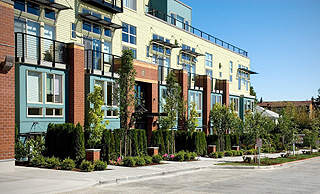
Surveys
DJC.COM
June 26, 2008
Planning our communities for a low-carbon future
Weber Thompson

Benotto
|
Global warming will affect your business no matter what it is, according to a recent article in the Harvard Business Review. Authors of the article “Competitive Advantage on a Warming Planet” predicted the green building community will profit from a carbon-constrained world.
To take advantage of this prediction, developers should start to rethink their development plans now and prepare for the changes that global warming will bring before change is forced on them by new regulations and shifting markets.
The city of Seattle, King County, Washington state and scores of municipalities are implementing or planning carbon-tracking measures in their SEPA checklists for new construction. These steps include measuring the amounts of carbon and other greenhouse gases emitted during construction, carbon embodied in the production of materials and carbon produced during operations, including transportation for the building’s occupants.

Photo courtesy of Weber Thompson Bagley Lofts connects a neighborhood of single-family houses with a commercial district and provides a mix of housing options. The project in Seattle’s Wallingford neighborhood received an award from the International Making Cities Livable Council. |
This tracking by jurisdictions is to determine a greenhouse gas emissions baseline in preparation for future required mitigation and possible carbon taxes or fees for exceeding certain limits. These possible taxes and fees have the potential to transform future development. To be successful, developers need to stay ahead of the curve.
Sprawl’s carbon effect
Due to their dependence on coal energy, buildings account for about half of greenhouse gas emissions nationwide. In the Seattle area, however, transportation is the largest contributor of greenhouse gas emissions, at 60 percent of the total.
While it is still critical to plan energy-efficient buildings, the location of a development, and the distance its occupants have to travel, may prove to be equally critical in keeping the carbon footprint, and possible penalties, down. This carbon accounting will reinforce the need for a dramatic increase in more compact, mixed-use, pedestrian-focused communities.
As gas prices soar, the demand for more fuel-efficient vehicles is skyrocketing, and some auto dealers are refusing to accept gas-guzzling SUVs as trade-ins. This increase in gas prices, along with growing concerns about global warming, might signal more radical changes in how and where people choose to live.
Even before the dramatic rise in gas prices, there were signs that market demand was changing. In a 1997 poll of residents in the San Francisco Bay Area, 60 percent said they would prefer a smaller home close to where they work, rather than a larger home farther away. Nationwide, a 2004 survey placed that preference at 48 percent. If these surveys were repeated today, chances are those percentages would be much higher.
Transportation has been the fastest growing source of atmospheric carbon dioxide within the United States, growing at a rate of 2 to 3 percent a year, according to the EPA. While solutions for cleaner fuels and more efficient vehicles exist, these improvements are typically negated by the amount people drive. Americans’ vehicle miles traveled, or VMT, has more than doubled since the 1970s. The VMT rate of growth has outpaced both employment growth and population growth.
By 2030, both the EPA and the Center for Clean Air Policy estimate a further 160 percent increase in VMT. At that accelerated pace, there is little hope for climate stabilization.
The very structure of our communities is pushing us to drive more. Communities have spread too far, consuming land at an inefficient rate that is 2.65 times higher than population growth. The amount of land developed jumped from 0.18-acre per person in the 1950s to 0.65-acre in 1988. This increase can be attributed in part to single-use zones that spread homes and services apart as well as to a wide hierarchical road pattern that forces longer, circuitous routes. In these communities, densities are frequently too low to make public transit viable.
Fortunately, the opportunity for change is great. According to Arthur C. Nelson in his article “Planning for a New Era,” which appeared in the Journal of the American Planning Association: “Nearly half of what will be the built environment in 2030 doesn’t even exist yet, giving the current generation a vital opportunity to reshape future development.”
Reshaping communities
For a low-carbon future, we will need a synergistic blend of land-efficient development, mixed-use neighborhoods and good urban design.
Studies by the Natural Resources Defense Council and Sierra Club show that driving is reduced 30 percent every time density doubles. A doubling of suburban density, therefore, would not only reduce carbon emissions, but would also provide greater housing options. As the number of households with children falls closer to 25 percent and the population continues to grow older, land-efficient options, such as townhouses and condominiums, are rising in popularity.
Higher residential density also helps support retail and commercial uses. According to an EPA study, for each 10 percent increase in retail floor area within a commercial building, there is a corresponding 8 percent decrease in VMT for occupants of that building.
A closer connection between jobs and housing is becoming more of a necessity and is at the forefront of rethinking comprehensive planning. This balance is more challenging to achieve at the micro level than it is at the macro level. People’s housing choices often outlast their job choices, and a proximity to work may apply for only one household member. However, with more overall balance provided, transit ridership goes up, bicycle use goes up and VMT goes down.
Road design with direct connections, rather than circuitous routes that funnel drivers to major arterials, is essential to reducing VMT. The old-fashioned street grid, with its straight lines and numerous intersections, works to reduce VMT. According to the Brookings Institution, as the number of intersections per acre goes up, the CO2 output per person goes down.
A shorter, more efficient road design is even better for transit, the pedestrian and the cyclist. We can increase walking and biking by providing safe and lively streetscapes with a mix of uses, such as banks, schools, drug stores, grocery stores, dry cleaners, offices and parks.
Integrated communities
All of these factors — compact, connected, mixed-use and urban design — work together to reduce the carbon footprint. Current examples are proving that it works: A recent report from the Brookings Institution analyzing the 100 largest metropolitan areas confirms that the current carbon footprints of metro-area residents are 14 percent smaller than the average American’s. In the book “Growing Cooler,” the authors predict that shifting 60 percent of new growth to compact patterns would save 85 million metric tons of CO2 annually by 2030.
We are on the cusp of dramatic change. Developers need to start strategizing about the location and layout of their future projects so they are poised to take advantage of density, mixed uses, proximity to transit and improved walk-ability — all to be better prepared for carbon restrictions. Along with shedding all that carbon, we’ll have designed places whose residents are healthier and happier.
Catherine Benotto, AIA, ASLA and LEED AP, is Weber Thompson’s principal in charge of community design and landscape. She also manages the firm’s Green Resource Group.
Other Stories:
- Corporate social responsibility turns green
- A green approach to gold mining in the Okanogan
- Financing evolves to benefit the environment
- Homeowners rethink their waterfronts
- Will Earthships save the Earth?
- Municipalities discover the benefits of eco-roofs
- What lies ahead for sustainable design?
- City, tribe team up on clean water project
- Architectural firm sets a zero-energy goal
- New stormwater discharge challenges loom
- Green building’s future lies in innovation, conservation
- Seattle becomes a hotbed for clean technologies
- Speed up sustainable development with a planned-action EIS
- Avoiding fish-related construction delays
Copyright ©2009 Seattle Daily Journal and DJC.COM.
Comments? Questions? Contact us.